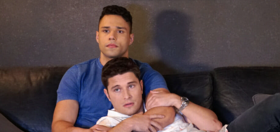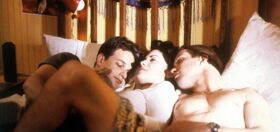 This Sunday, Folsom Street in San Francisco between 8th and 13th streets will close down to car traffic and welcome over 400,000 people to the largest kink and leather event of its kind. If you’ve never attended a Folsom Street Fair, you’ve surely seen photos.
This Sunday, Folsom Street in San Francisco between 8th and 13th streets will close down to car traffic and welcome over 400,000 people to the largest kink and leather event of its kind. If you’ve never attended a Folsom Street Fair, you’ve surely seen photos.
But how did we get here?
To dig into the history of the Folsom Street Fair is to walk through the development of San Francisco from post-WWII port city to its current state, and weaves with it the narratives of gay rights, the war on poverty and the emergence of the leather and kink subculture.
Here’s a run-down of how the truly one-of-a-kind event came to be:
How about we take this to the next level?
Our newsletter is like a refreshing cocktail (or mocktail) of LGBTQ+ entertainment and pop culture, served up with a side of eye-candy.
- In the 1940s, thousands of male servicemen were given “blue discharges” for homosexual conduct. They landed back in the nation’s major port cities, contributing to the burgeoning gay populations in cities like New York, Chicago and San Francisco.
- San Francisco’s South of Market (SoMa) neighborhood (the epicenter of SF’s gay leather scene and where Folsom St. Fair takes place) was a poor, working class neighborhood where many single men resided. Honky-tonks, whorehouses, and gambling dens were scattered throughout the area.
- By the mid-’60s, SoMa emerged as a hub of the gay leather scene. The first leather bar in SoMa was the Tool Box, which opened in 1961 at 339 4th St. (which is,of all things, now a Whole Foods). In 1964, Life magazine published an article called “Homosexuality in America,” profiling The Tool Box and cementing San Francisco and SoMa as the capital of gay deviance in the minds many Americans. More than ever, gays came flocking to the city.
-

Image from LIFE Magazine depicting The Tool Box. 1964 At the same time there was a large activist movement in the city to fight poverty. One major player was the Society for Individual Rights (SIR), the largest queer organization at the time. SIR worked in SOMA to protect the neighborhood’s residents.
- This strong community-based resistance to redevelopment efforts continued through the ’70s. In 1978, activists filed a series of lawsuits on environmental grounds which failed to halt the construction of the current Yerba Buena Park, convention center and museum complex.
- By the late ’70s, SoMa’s “miracle mile” included nearly 30 different leather bars, clubs, merchants and bathhouses.
- Kathleen Connell and Michael Valerio began working with activist groups in 1980 and held the first Folsom Street Fair in 1984 as a community protest against redevelopment. A major goal (among many) was to establish the neighborhood not as a blighted area in need of rebuilding, but an already thriving community. The fair was called “Megahood.”
- Another major component of the first fair was to proclaim healing and support for the LGBT community — and leather community — in the throes of the AIDS crisis.
- After the success of the first Folsom Street Fair, organizers created the “Up Your Alley Fair” on Ringold Street in 1985. This fair moved to Dore Street (“Dore Alley”) between Harrison and Folsom in 1987.
- As fundraising to combat AIDS continued to be a major priority, Folsom Street Fair quickly became more about the LGBT and leather communities, especially as the city continued to shut down bathhouses and bars due to concerns about public health.
- Through the ’90s and ’00s, the leather and kink components of the fair have taken center stage, and though the fair is still a largely gay event, it incorporates all sexualities and genders. Here are some images of the 1990 and 1993 Folsom St. Fairs, courtesy of Lloyd Cook:






- The fair now draws crowds in excess of 400,000 to the streets of SoMa every September.
- Spinoffs now include Folsom Street East (New York), Folsom Street North (Toronto), and Folsom Europe (Berlin)
For more on this years fair, check out the GayCities guide to the Folsom Street Fair.
For more Folsom History, we highly recommend the new documentary Folsom Forever.



















VampDC
The history behind it is Trashy people coming together.
Paco
I would like to go sometime. Looks like older guys are welcome.
SportGuy
Sexy men! 😀
dewin
@VampDC:
Huh?
underboy
trashy people are the best! a lot better to be around than those with sticks (metaphorically) up their asses.
@paco, folsom is probably the single best event in the world where you see older guys not just welcome but highly sexualized and desired. the leather community has always outpaced others in that regard.
jantheman
don’t see the need for it. and its great for fox news..and the homophobes here in midwest who want even more of a reason to hate me..the human urinal ect.
seaguy
@VampDC: The trash is haters like you who have to troll the comments on here and leave your nasty comments everytime.
seaguy
I wish I could attend. Folsom looks like a fun time to people watch 😉
Saint Law
Dear human urinal etc or can I call you Jan?
It’s sad that midwestern homophobes hate you. Perhaps you should, you know, stop letting them piss in your mouth?
Just a thought.
A Friend
xx
AzLights
@ seaguy: I attended several times with friends. It’s fun and yes, the people watching can get interesting.
@jantheman: If that isn’t your thing, then don’t go. I’m not into leather, nor is my wife but I don’t have issues with it. As for the homophobes, screw ’em. If not events like Folsom Street, they would and do find other stuff to get their knickers in a twist over. As for some of the anti-gay activists, I suspect it’s just one of Porno Pete’s few outlets.
vive
I don’t know what you would call living your life worrying about what conservative people will think of you, but living on eggshells like that is NOT liberation, and it is NOT freedom.
vive
Sorry. Context. That was in response to jantheman.
Bauhaus
Kinky Boots? Now I can’t get this song out of my head!
http://vimeo.com/8205387
Geeker
Isn’t it just all porn stars and old circuit queens now?
jantheman
@Saint Law: haha. yea i misworded. am not the human urinal. he is an example of what is not needed outside. people live in those apartments above including children.
jantheman
@vive: i worry bout what my liberal friends think. not all are ok with public groping, hard body play. again..rent a facility.there r huge ones.
jantheman
@AzLights: why should i not go because of illegal activities being performed?
wpewen
To each his own. I lived near it in early 80’s. The entire leather scene is one of the things about urban gay culture that really pisses off a lot of straight guys who really do wear hardhats for work. Folsom’s just a big porn shoot.
wpewen
Also, one reason I don’t like stuff like Folsom is i do care what straight guys think of us. I worked as a nurseryman and have been around some pretty nice conservative blue collar men who just don’t understand why some gay guys have to do street theater with what’s fun behind closed doors.
partypig
I stopped going after I ended up in a porn video without my consent.
mz.sam
Oh yeah, Folsom is invaded with hot muscled daddies and porn stars, but what isn’t seen is the most jaw-dropping display of fetish freaks, pleather queens and pendulous naked mammary dykes. One will ever see such a cornucopia of humanity in one single event.
freak_thing
In addition to the fabulous sleaze of Folsom and its rejection of normalcy, it consistently raises money for charities (and not just LGBT ones). Both it and the Castro Street Fair are also timed for the last weekends for voter registration. Now that’s real coalition building.
vive
@wpewen, @jantheman, Folsom has a LOT of straight fetish participants too. And jantheman, if your friends are as liberal as you say, they wouldn’t care. As for your conservative friends wpewen, they probably hate hippies, peaceniks, trans people, fem guys, and Occupiers too, so I wouldn’t pay much attention to what they think.
As for saying it’s illegal, first, gay sex was long illegal, so that is not an argument, and second, it is NOT illegal where the fair is held.
Maude
Yeah, but what about us “Tough Twinks?” We want a parade too!
AzLights
@jantheman: Then don’t take them to Folsom. I suspect my wife might find Folsom offensive and until I am told otherwise, I won’t take her.
Geeker
Leather to be is like drag for guys trying to prove how butch they are.
vive
@Geeker, we were born naked. Everything else is drag.
Paco
@Geeker: I don’t think they all wear leather for that reason, but your comment did remind me of my first visit to a leather bar years ago. I was terrified by all the butch looking men, but soon began to notice how many had “purses flying out of their mouths”. Then I felt right at home. They were still hot to look at.
octinny
say what you want but I went for the first time about 4 years ago and I had the time of my life. I had never seen anything like it and found myself wanting to do things that I only dreamed of doing with some of the participants. That was like Disneyland to me.
I am thankful for self expression and if that shocks people.. then don’t go. I need to hit the shower now.
Jack Fritscher
For more “local color” on the history of Folsom Fair written by a longtime eyewitness photographer and author: http://www.bartabsf.com/2011/08/leather%E2%80%99s-burning-man/
octinny
Whew…don’t know if I could handle as much as he does but I actually enjoy it.
jantheman
to vive:same goes for straight fetishists. take it inside and where in the description of liberal does it say” accepting of every act”? and azlights..why should i have to change my behavior or walking route? take it inside and put many of the registration booths ect on the outside. there IS an answer. but its just not as sleazy. oh and vive..some acts are illegal no matter what gender. am not talking about based on gender. and i cannot find a statement on the legality of the acts performed. i suspect the huge amount of money raised has them look the other way. invite me to a party with w/s or fisting or slings..am there. tell me children or nonconsenting adults may be exposed..am not.
ag.eric
@jantheman: Folsom is not open to children or passersby. You have to pass an entrance gate and pay admission. And they do prohibit and monitor for public sex acts that include penetration or w/s. There are plenty of real cops around to assure that.
tukausseystudio
@VampDC: Treshy enough for you to read the article.
vive
@jantheman, you are privileged and rich enough to live in San Francisco (which has gentrified many regular gay and queer people out of the city altogether) and you are bothered that you have to “change my walking route” and now want to change the city to your liking (i.e., to be PG) by eliminating a historical queer event you consider trashy?
Truly, give them some money and gay yuppies are even bigger a-holes than straight yuppies.
Geeker
It must smell like piss and poppers.
Geeker
What’s really sad is that most of the guys in those old photos are probably long dead now.
jantheman
@vive: Vive..(amazing how rude people are when they hide behind nicknames). No I have visited SF about 8 times. I live in rural nebraska, near omaha and am on disability due to cancer and its complications.and yes hangin onto my internet lol. If you check, the total is about 1400/month. But i do care about places I have visited. And I was not aware that sex acts were PG. To me open fondling of erections, oral sex ect is not PG. And regular people do live in the area and above. thank you for your concern regarding my income. I have no interest in yours.
Geeker
@jantheman: Some just can’t enjoy anything unless they have an audience,be they a willing audience or not.
vive
@jantheman, so you don’t even live in San Francisco and you want them to ban things because they made you “change your walking route”? That’s even worse.
Geeker
Call Jessica Lange cause the real freak show is in SF.
jantheman
@vive: ah…vive. i made my main point over n over so am done.clearly you are a troll..so ..am done with you.
Geeker
Maybe wrecking ball guy will get his own show.
sfcarlos65
I’ve not attended The Folsom Street Fair in many years, but I remember the erotic energy, it was incredible.